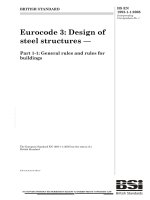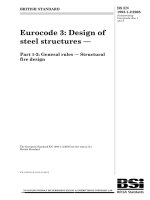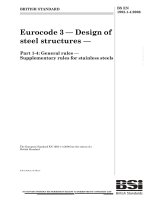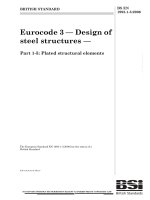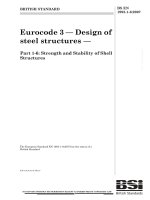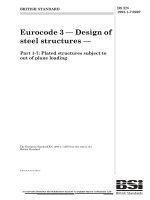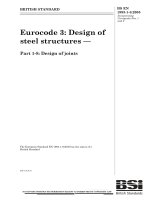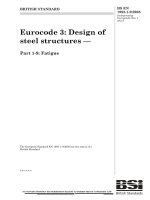Tiêu chuẩn Châu Âu EC3: Kết cấu thép phần 1.7: Kết cấu tấm vỏ chịu lực ngoài mặt phẳng (Eurocode3 BS EN1993 1 7 e 2007 Design of steel structures part 1.7: Plated structure subjected to out of plane loading)
Bạn đang xem bản rút gọn của tài liệu. Xem và tải ngay bản đầy đủ của tài liệu tại đây (433 KB, 40 trang )
BRITISH STANDARD
Eurocode 3 — Design of
steel structures —
Part 1-7: Plated structures subject to
out of plane loading
The European Standard EN 1993-1-7:2007 has the status of a
British Standard
ICS 91.010.30; 91.080.10
--```,,`,`````,,`,,``,`,,,,,`,,-`-`,,`,,`,`,,`---
12 &23<,1* :,7+287 %6, 3(50,66,21 (;&(37 $6 3(50,77(' %< &23<5,*+7 /$:
BS EN
1993-1-7:2007
BS EN 1993-1-7:2007
National foreword
This British Standard is the UK implementation of EN 1993-1-7:2007.
The structural Eurocodes are divided into packages by grouping Eurocodes for
each of the main materials: concrete, steel, composite concrete and steel,
timber, masonry and aluminium; this is to enable a common date of
withdrawal (DOW) for all the relevant parts that are needed for a particular
design. The conflicting national standards will be withdrawn at the end of the
coexistence period, after all the EN Eurocodes of a package are available.
Following publication of the EN, there is a period allowed for national
calibration during which the National Annex is issued, followed by a further
coexistence period of a maximum three years. During the coexistence period
Member States will be encouraged to adapt their national provisions to
withdraw conflicting national rules before the end of the coexistent period in
March 2010. At the end of this coexistence period, the national standard(s) will
be withdrawn.
In the UK, the following corresponding national standard is partially
superseded by BS EN 1993-1-7:
BS 5400-3:2000, Steel, concrete and composite bridges — Code of practice for
design of steel bridges
and based on this transition period, these standards will be withdrawn at the
latest by March 2010.
The UK participation in its preparation was entrusted by Technical Committee
B/525, Building and civil engineering structures, to Subcommittee B/525/31,
Structural use of steel.
A list of organizations represented on this subcommittee can be obtained on
request to its secretary.
Where a normative part of this EN allows for a choice to be made at the
national level, the range and possible choice will be given in the normative text,
and a note will qualify it as a Nationally Determined Parameter (NDP). NDPs
can be a specific value for a factor, a specific level or class, a particular method
or a particular application rule if several are proposed in the EN.
To enable EN 1993-1-7 to be used in the UK, the NDPs will be published in a
National Annex, which will be made available by BSI in due course, after
public consultation has taken place.
This publication does not purport to include all the necessary provisions of a
contract. Users are responsible for its correct application.
Compliance with a British Standard cannot confer immunity from
legal obligations.
This British Standard was
published under the authority
of the Standards Policy and
Strategy Committee
on 31 July 2007
Amendments issued since publication
Amd. No.
© BSI 2007
ISBN 978 0 580 53282 5
--```,,`,`````,,`,,``,`,,,,,`,,-`-`,,`,,`,`,,`---
Date
Comments
EUROPEAN STANDARD
EN 1993-1-7
NORME EUROPÉENNE
EUROPÄISCHE NORM
April 2007
ICS 91.010.30; 91.080.10
Supersedes ENV 1993-1-7:1999
English Version
Eurocode 3 - Design of steel structures - Part 1-7: Plated
structures subject to out of plane loading
Eurocode 3 - Calcul des structures en acier - Partie 1-7:
Résistance et stabilité des structures en plaques planes
chargées hors de leur plan
Eurocode 3 - Bemessung und Konstruktion von
Stahlbauten - Teil 1-7: Plattenförmige Bauteile mit
Querbelastung
This European Standard was approved by CEN on 12 June 2006.
CEN members are bound to comply with the CEN/CENELEC Internal Regulations which stipulate the conditions for giving this European
Standard the status of a national standard without any alteration. Up-to-date lists and bibliographical references concerning such national
standards may be obtained on application to the CEN Management Centre or to any CEN member.
This European Standard exists in three official versions (English, French, German). A version in any other language made by translation
under the responsibility of a CEN member into its own language and notified to the CEN Management Centre has the same status as the
official versions.
CEN members are the national standards bodies of Austria, Belgium, Bulgaria, Cyprus, Czech Republic, Denmark, Estonia, Finland,
France, Germany, Greece, Hungary, Iceland, Ireland, Italy, Latvia, Lithuania, Luxembourg, Malta, Netherlands, Norway, Poland, Portugal,
Romania, Slovakia, Slovenia, Spain, Sweden, Switzerland and United Kingdom.
EUROPEAN COMMITTEE FOR STANDARDIZATION
COMITÉ EUROPÉEN DE NORMALISATION
EUROPÄISCHES KOMITEE FÜR NORMUNG
Management Centre: rue de Stassart, 36
© 2007 CEN
All rights of exploitation in any form and by any means reserved
worldwide for CEN national Members.
--```,,`,`````,,`,,``,`,,,,,`,,-`-`,,`,,`,`,,`---
B-1050 Brussels
Ref. No. EN 1993-1-7:2007: E
EN 1993-1-7: 2007 (E)
Content
Page
Foreword ...........................................................................................................................................................3
1
General.......................................................................................................................................................4
1.1 Scope ................................................................................................................................................4
1.2 Normative references........................................................................................................................4
1.3 Terms and definitions .......................................................................................................................5
1.4 Symbols ............................................................................................................................................6
2
Basis of design ...........................................................................................................................................9
2.1 Requirements....................................................................................................................................9
2.2 Principles of limit state design..........................................................................................................9
2.3 Actions..............................................................................................................................................9
2.4 Design assisted by testing...............................................................................................................10
3
Material properties .................................................................................................................................10
4
Durability.................................................................................................................................................10
5
Structural analysis ..................................................................................................................................10
5.1 General ...........................................................................................................................................10
5.2 Stress resultants in the plate............................................................................................................10
6
Ultimate limit state..................................................................................................................................15
6.1 General ...........................................................................................................................................15
6.2 Plastic limit.....................................................................................................................................15
6.3 Cyclic plasticity ..............................................................................................................................16
6.4 Buckling resistance.........................................................................................................................17
7
Fatigue .....................................................................................................................................................18
8
Serviceability limit state .........................................................................................................................18
8.1 General ...........................................................................................................................................18
8.2 Out of plane deflection ...................................................................................................................18
8.3 Excessive vibrations .......................................................................................................................18
Annex A [informative] – Types of analysis for the design of plated structures ........................................19
A.1 General ...........................................................................................................................................19
A.2 Linear elastic plate analysis (LA)...................................................................................................19
A.3 Geometrically nonlinear analysis (GNA) .......................................................................................19
A.4 Materially nonlinear analysis (MNA).............................................................................................20
A.5 Geometrically and materially nonlinear analysis (GMNA)............................................................20
A.6 Geometrically nonlinear analysis elastic with imperfections included (GNIA) .............................20
A.7 Geometrically and materially nonlinear analysis with imperfections included (GMNIA).............20
Annex B [informative] – Internal stresses of unstiffened rectangular plates from small
deflection theory .............................................................................................................................................21
B.1 General ...........................................................................................................................................21
B.2 Symbols ..........................................................................................................................................21
B.3 Uniformly distributed loading ........................................................................................................21
B.4 Central patch loading......................................................................................................................24
Annex C [informative] – Internal stresses of unstiffened rectangular plates from large
deflection theory .............................................................................................................................................26
C.1 General ...........................................................................................................................................26
C.2 Symbols ..........................................................................................................................................26
C.3 Uniformly distributed loading on the total surface of the place .....................................................26
C.4 Central patch loading......................................................................................................................32
2
--```,,`,`````,,`,,``,`,,,,,`,,-`-`,,`,,`,`,,`---
EN 1993-1-7: 2007 (E)
Foreword
Foreword
This European Standard EN 1993-1-7, Eurocode 3: Design of steel structures: Part 1-7 Plated structures
subject to out of plane loading, has been prepared by Technical Committee CEN/TC250 « Structural
Eurocodes », the Secretariat of which is held by BSI. CEN/TC250 is responsible for all Structural Eurocodes.
This European Standard shall be given the status of a National Standard, either by publication of an identical
text or by endorsement, at the latest by October 2007, and conflicting National Standards shall be withdrawn at
latest by March 2010.
This Eurocode supersedes ENV 1993-1-7.
According to the CEN-CENELEC Internal Regulations, the National Standard Organizations of the
following countries are bound to implement this European Standard: Austria, Belgium, Bulgaria Cyprus, Czech
Republic, Denmark, Estonia, Finland, France, Germany, Greece, Hungary, Iceland, Ireland, Italy, Latvia,
Lithuania, Luxembourg, Malta, Netherlands, Norway, Poland, Portugal, Romania, Slovakia, Slovenia, Spain,
Sweden, Switzerland and United Kingdom.
National annex for EN 1993-1-7
--```,,`,`````,,`,,``,`,,,,,`,,-`-`,,`,,`,`,,`---
This standard gives alternative procedures, values and recommendations with notes indicating where national
choices may have to be made. The National Standard implementing EN 1993-1-7 should have a National
Annex containing all Nationally Determined Parameters to be used for the design of steel structures to be
constructed in the relevant country.
National choice is allowed in EN 1993-1-7 through:
–
6.3.2(4)
3
EN 1993-1-7: 2007 (E)
1
General
1.1
Scope
(1)P EN 1993-1-7 provides basic design rules for the structural design of unstiffened and stiffened plates
which form part of plated structures such as silos, tanks or containers, that are loaded by out of plane actions.
It is intended to be used in conjunction with EN 1993-1-1 and the relevant application standards.
(2) This document defines the design values of the resistances: the partial factor for resistances may be
taken from National Annexes of the relevant application standards. Recommended values are given in the
relevant application standards.
(3)
This Standard is concerned with the requirements for design against the ultimate limit state of:
–
plastic collapse;
–
cyclic plasticity;
–
buckling;
–
fatigue.
(4) Overall equilibrium of the structure (sliding, uplifting, overturning) is not included in this Standard,
but is treated in EN 1993-1-1. Special considerations for specific applications may be found in the relevant
applications parts of EN 1993.
(5) The rules in this Standard refer to plate segments in plated structures which may be stiffened or
unstiffened. These plate segments may be individual plates or parts of a plated structure. They are loaded by
out of plane actions.
(6) For the verification of unstiffened and stiffened plated structures loaded only by in-plane effects see
EN 1993-1-5. In EN 1993-1-7 rules for the interaction between the effects of inplane and out of plane
loading are given.
(7)
For the design rules for cold formed members and sheeting see EN 1993-1-3.
(8) The temperature range within which the rules of this Standard are allowed to be applied are defined in
the relevant application parts of EN 1993.
(9) The rules in this Standard refer to structures constructed in compliance with the execution
specification of EN 1090-2.
(10) Wind loading and bulk solids flow should be treated as quasi-static actions. For fatigue, the dynamic
effects must be taken into account according to EN 1993-1-9. The stress resultants arising from the dynamic
behaviour are treated in this part as quasi-static.
1.2
Normative references
(1) This European Standard incorporates, by dated or undated reference, provisions from other
publications. These normative references are cited at the appropriate places in the text and the publications
are listed hereafter. For dated references, subsequent amendments to or revisions of any of these publications
apply to this European Standard only when incorporated in it by amendment or revision. For undated
references the latest edition of the publication referred to applies.
EN 1993
Eurocode 3: Design of steel structures:
Part 1.1:
General rules and rules for buildings
Part 1.3:
Cold-formed members and sheeting
Part 1.4:
Stainless steels
Part 1.5:
Plated structural elements
--```,,`,`````,,`,,``,`,,,,,`,,-`-`,,`,,`,`,,`---
4
EN 1993-1-7: 2007 (E)
--```,,`,`````,,`,,``,`,,,,,`,,-`-`,,`,,`,`,,`---
1.3
Part 1.6:
Strength and stability of shell structures
Part 1.8:
Design of joints
Part 1.9:
Fatigue strength of steel structures
Part 1.10:
Selection of steel for fracture toughness and through-thickness properties
Part 1.12:
Additional rules for the extension of EN 1993 up to steel grades S700
Part 4.1:
Silos
Part 4.2:
Tanks
Terms and definitions
(1)
The rules in EN 1990, clause 1.5 apply.
(2)
The following terms and definitions are supplementary to those used in EN 1993-1-1:
1.3.1
Structural forms and geometry
1.3.1.1
Plated structure
A structure that is built up from nominally flat plates which are joined together. The plates may be stiffened
or unstiffened, see Figure 1.1.
Plated structure
Transverse stiffener (trough or closed)
Longitudinal stiffeners (open or closed)
Plate segment
Subpanels
Figure 1.1: Components of a plated structure
1.3.1.2
Plate segment
A plate segment is a flat plate which may be unstiffened or stiffened. A plate segment should be regarded as
an individual part of a plated structure.
1.3.1.3
Stiffener
A plate or a section attached to the plate with the purpose of preventing buckling of the plate or reinforcing it
against local loads. A stiffener is denoted:
–
longitudinal if its longitudinal direction is in the main direction of load transfer of the member of
which it forms a part.
–
transverse if its longitudinal direction is perpendicular to the main direction of load transfer of the
member of which it forms a part.
5
EN 1993-1-7: 2007 (E)
--```,,`,`````,,`,,``,`,,,,,`,,-`-`,,`,,`,`,,`---
1.3.1.4
Stiffened plate
Plate with transverse and/or longitudinal stiffeners.
1.3.1.5
Sub-panel
Unstiffened plate surrounded by stiffeners or, on a web, by flanges and/or stiffeners or, on a flange, by webs
and/or stiffeners.
1.3.2
Terminology
1.3.2.1
Plastic collapse
A failure mode at the ultimate limit state where the structure loses its ability to resist increased loading due to
the development of a plastic mechanism.
1.3.2.2
Tensile rupture
A failure mode in the ultimate limit state where failure of the plate occurs due to tension.
1.3.2.3
Cyclic plasticity
Where repeated yielding is caused by cycles of loading and unloading.
1.3.2.4
Buckling
Where the structure looses its stability under compression and/or shear.
1.3.2.5
Fatigue
Where cyclic loading causes cracking or failure.
1.3.3
Actions
1.3.3.1
Out of plane loading
The load applied normal to the middle surface of a plate segment.
1.3.3.2
In-plane forces
Forces applied parallel to the surface of the plate segment. They are induced by in-plane effects (for example
temperature and friction effects) or by global loads applied at the plated structure.
1.4
Symbols
(1)
In addition to those given in EN 1990 and EN 1993-1-1, the following symbols are used:
(2)
Membrane stresses in rectangular plate, see Figure 1.2:
σmx
is the membrane normal stress in the x-direction due to membrane normal stress resultant per unit
width nx;
σmy
is the membrane normal stress in the y-direction due to membrane normal stress resultant per unit
width ny;
τmxy
is the membrane shear stress due to membrane shear stress resultant per unit width nxy.
6
EN 1993-1-7: 2007 (E)
dx
dy
nx
σmx
τmxy
τmyx
ny
σmy
Figure 1.2: Membrane stresses
(3)
Bending and shear stresses in rectangular plates due to bending, see Figure 1.3:
σbx
is the stress in the x-direction due to bending moment per unit width mx;
σby
is the stress in the y-direction due to bending moment per unit width my;
τbxy
is the shear stress due to the twisting moment per unit width mxy;
τbxz
is the shear stress due to transverse shear forces per unit width qx associated with bending;
τbyz
is the shear stress due to transverse shear forces qy associated with bending.
dx
dy
τ byx
τbyz
my
q
y
myx
τbxz
mx qx
τbxy
mxy
σbx
σby
Figure 1.3: Normal and shear stresses due to bending
NOTE: In general, there are eight stress resultants in a plate at any point. The shear stresses τbxz and τbyz due
to qx and qy are in most practical cases insignificant compared to the other components of stress, and
therefore they may normally be disregarded for the design.
(4)
Greek lower case letters:
α
aspect ratio of a plate segment (a/b);
ε
strain;
αR
load amplification factor;
ρ
reduction factor for plate buckling;
σi
Normal stress in the direction i, see Figure 1.2 and Figure 1.3;
--```,,`,`````,,`,,``,`,,,,,`,,-`-`,,`,,`,`,,`---
7
EN 1993-1-7: 2007 (E)
τ
Shear stress, see Figure 1.2 and Figure 1.3;
ν
Poisson's ratio;
γM
partial factor.
(5)
Latin upper case letter:
E
Modulus of elasticity
(6)
Latin lower case letters:
a
length of a plate segment, see Figure 1.4 and Figure 1.5;
b
width of a plate segment, see Figure 1.4 and Figure 1.5;
fyk
yield stress or 0,2% proof stress for material with non linear stress-strain curve;
ni
membrane normal force in the direction i [kN/m];
nxy
membrane shear force [kN/m}
m
bending moment [kNm/m];
qz
transverse shear force in the z direction [kN/m];
t
thickness of a plate segment, see figure 1.4 and 1.5.
NOTE: Symbols and notations which are not listed above are explained in the text where they first appear.
Figure 1.5: Dimensions and axes of stiffened plate segments; stiffeners may be
open or closed stiffeners
8
--```,,`,`````,,`,,``,`,,,,,`,,-`-`,,`,,`,`,,`---
Figure 1.4: Dimensions and axes of unstiffened plate segments
EN 1993-1-7: 2007 (E)
2
Basis of design
2.1
Requirements
(1)P The basis of design shall be in accordance with EN 1990.
(2)P The following ultimate limit states shall be checked for a plated structure:
–
plastic collapse, see 2.2.2;
–
cyclic plasticity, see 2.2.3;
–
buckling, see 2.2.4;
–
fatigue, see 2.2.5.
(3) The design of a plated structure should satisfy the serviceability requirements set out in the appropriate
application standards.
2.2
Principles of limit state design
2.2.1
General
(1)P The principles for ultimate limit state given in section 2 of EN 1993-1-1 and EN 1993-1-6 shall also be
applied to plated structures.
2.2.2
Plastic collapse
(1) Plastic collapse is defined as the condition in which a part of the structure develops excessive plastic
deformations, associated with development of a plastic mechanism. The plastic collapse load is usually
derived from a mechanism based on small deflection theory.
Cyclic plasticity
(1) Cyclic plasticity should be taken as the limit condition for repeated cycles of loading and unloading
produce yielding in tension or in compression or both at the same point, thus causing plastic work to be
repeatedly done on the structure. This alternative yielding may lead to local cracking by exhaustion of the
material's energy absorption capacity, and is thus a low cycle fatigue restriction. The stresses which are
associated with this limit state develop under a combination of all actions and the compatibility conditions
for the structure.
2.2.4
Buckling
(1) Buckling should be taken as the condition in which all or parts of the structure develop large
displacements, caused by instability under compressive and/or shear stresses in the plate. It leads eventually
to inability to sustain an increase in the stress resultants.
(2)
Local plate buckling, see EN 1993-1-5.
(3)
For flexural, lateral torsional and distortional stability of stiffeners, see EN 1993-1-5
2.2.5
Fatigue
(1) Fatigue should be taken as the limit condition caused by the development and / or growth of cracks by
repeated cycles of increasing and decreasing stresses.
2.3
(1)
Actions
The characteristic values of actions should be determined from the appropriate parts of EN 1991.
9
--```,,`,`````,,`,,``,`,,,,,`,,-`-`,,`,,`,`,,`---
2.2.3
EN 1993-1-7: 2007 (E)
2.4
Design assisted by testing
(1) For design assisted by testing reference should be made to section 2.5 of EN 1993-1-1 and where
relevant, Section 9 of EN 1993-1-3.
3
Material properties
(1) This Standard covers the design of plated structures fabricated from steel material conforming to the
product standards listed in EN 1993-1-1 and EN 1993-1-12.
(2)
The material properties of cold formed members and sheeting should be obtained from EN 1993-1-3.
(3)
The material properties of stainless steels should be obtained from EN 1993-1-4.
4
(1)
Durability
For durability see section 4 of EN 1993-1-1.
5
Structural analysis
5.1
General
(1)P The models used for calculations shall be appropriate for predicting the structural behaviour and the
limit states considered.
(2) If the boundary conditions can be conservatively defined, i.e. restrained or unrestrained, a plated
structure may be subdivided into individual plate segments that may be analysed independently.
(3)P The overall stability of the complete structure shall be checked following the relevant parts of
EN 1993.
5.2
Stress resultants in the plate
5.2.1
General
(1) The calculation model and basic assumptions for determining internal stresses or stress resultants
should correspond to the assumed structural response for the ultimate limit state loading.
(2) Structural models may be simplified such that it can be shown that the simplifications used will give
conservative estimates of the effects of actions.
--```,,`,`````,,`,,``,`,,,,,`,,-`-`,,`,,`,`,,`---
(3) Elastic global analysis should generally be used for plated structures. Where fatigue is likely to occur,
plastic global analysis should not be used.
(4)
Possible deviations from the assumed directions or positions of actions should be considered.
(5) Yield line analysis may be used in the ultimate limit state when inplane compression or shear is less
than 10% of the corresponding resistance. The bending resistance in a yield line should be taken as
m Rd =
5.2.2
(1)
10
0,25 ⋅ f y ⋅ t 2
γ M0
Plate boundary conditions
Boundary conditions assumed in analyses should be appropriate to the limit states considered.
EN 1993-1-7: 2007 (E)
(2)P If a plated structure is subdivided into individual plate segments the boundary conditions assumed for
stiffeners in individual plate segments in the design calculations shall be recorded in the drawings and
project specification.
5.2.3
Design models for plated structures
5.2.3.1
(1)
General
The internal stresses of a plate segment should be determined as follows:
–
standard formulae, see 5.2.3.2;
–
global analysis, see 5.2.3.3;
–
simplified models, see 5.2.3.4.
(2) The design methods given in (1) should take into account a linear or non linear bending theory for
plates as appropriate.
(4) A non-linear bending theory is based on large-deflection assumptions and the effects of deformation
on equilibrium are taken into account.
(5)
The design models given in (1) may be based on the types of analysis given in Table 5.1.
Table 5.1: Types of analysis
Type of analysis
Bending theory
Material law
Plate geometry
linear
linear
perfect
non-linear
linear
perfect
linear
non-linear
perfect
Geometrically and materially non-linear
analysis (GMNA)
non-linear
non-linear
perfect
Geometrically non-linear elastic analysis
with imperfections (GNIA)
non-linear
linear
imperfect
Geometrically and materially non-linear
analysis with imperfections (GMNIA)
non-linear
non-linear
imperfect
Linear elastic plate analysis (LA)
Geometrically non-linear elastic analysis
(GNA)
Materially non-linear analysis (MNA)
NOTE 1: A definition of the different types of analysis is given in Annex A.
NOTE 2: The type of analysis appropriate to a structure should be stated in the project specification.
NOTE 3: The use of a model with perfect geometry implies that geometrical imperfections are either not
relevant or included through other design provisions.
NOTE 4: Amplitudes for geometrical imperfections for imperfect geometries are chosen such that in
comparisons with results from tests using test specimens fabricated with tolerances according to EN 1090-2
the calculative results are reliable, therefore these amplitudes in general differ from the tolerances given in
EN 1090-2.
5.2.3.2
Use of standard formulas
(1) For an individual plate segment of a plated structure the internal stresses may be calculated for the
relevant combination of design actions with appropriate design formulae based on the types of analysis given
in 5.2.3.1.
11
--```,,`,`````,,`,,``,`,,,,,`,,-`-`,,`,,`,`,,`---
(3) A linear bending theory is based on small-deflection assumptions and relates loads to deformations in
a proportional manner. This may be used if inplane compression or shear is less than 10% of the
corresponding resistance.
EN 1993-1-7: 2007 (E)
NOTE: Annex B and Annex C provide tabulated values for rectangular unstiffened plates which are
loaded transversely. For circular plates design formulas are given in EN 1993-1-6. Further design formulas
may be used, if the reliability of the design formulas is in accordance with the requirements given in
EN 1991-1.
(2) In case of a two dimensional stress field resulting from a membrane theory analysis the equivalent
Von Mises stress σeq,Ed may be determined by
σ eq, Ed =
1 2
n x, E d + n 2y, E d - n x, E d n y,E d + 3 n 2xy, E d
t
(5.1)
(3) In case of a two dimensional stress field resulting from an elastic plate theory the equivalent
Von Mises stress σeq,Ed may be determined, as follows:
σ eq, Ed = σ 2x, E d + σ 2y,E d - σ x, E d σ y,E d + 3τ 2xy, E d
n x, E d m x, E d
± 2
t
t /4
where σ x, E d =
σ y,Ed =
(5.2)
n y,Ed m y,Ed
± 2
t
t /4
τ xy, Ed =
n xy, Ed m xy, Ed
± 2
t
t /4
and nx,Ed, ny,Ed, nxy,Ed, mx,Ed, my,Ed and mxy,Ed are defined in 1.4(1) and (2).
NOTE:
5.2.3.3
The above expressions give a simplified conservative equivalent stress for design
Use of a global analysis: numerical analysis
(1) If the internal stresses of a plated structure are determined by a numerical analysis which is based on a
materially linear analysis, the maximum equivalent Von Mises stress σeq,Ed of the plated structure should be
calculated for the relevant combination of design actions.
(2) The equivalent Von Mises stress σeq,Ed is defined by the stress components which occurred at one point
in the plated structure.
σ eq ,Ed = σ x2,Ed + σ y2,Ed − σ x ,Ed ⋅ σ y ,Ed + 3τ xy2 ,Ed
(5.3)
where σx,Ed and σy,Ed are positive in case of tension.
(3) If a numerical analysis is used for the verification of buckling, the effects of imperfections should be
taken into account. These imperfections may be:
(a)
geometrical imperfections:
–
deviations from the nominal geometric shape of the plate (initial deformation, out of plane
deflections);
–
irregularities of welds (minor eccentricities);
–
deviations from nominal thickness.
(b)
material imperfections:
–
residual stresses because of rolling, pressing , welding, straightening;
–
non-homogeneities and anisotropies.
12
--```,,`,`````,,`,,``,`,,,,,`,,-`-`,,`,,`,`,,`---
EN 1993-1-7: 2007 (E)
(4) The geometrical and material imperfections should be taken into account by an initial equivalent
geometric imperfection of the perfect plate. The shape of the initial equivalent geometric imperfection should
be derived from the relevant buckling mode.
(5) The amplitude of the initial equivalent geometric imperfection e0 of a rectangular plate segment may
be derived by numerical calibrations with test results from test pieces that may be considered as
representative for fabrication from the plate buckling curve of EN 1993-1-5, as follows:
e0 =
(1 - ρ λ 2p ) ( 1 - ρ )
where ζ =
ρ
(5.4)
ρζ
6 b2 ( b2 + ν a 2 )
t ( a 2 + b2 )2
and α <
2
is the reduction factor for plate buckling as defined in 4.4 of EN 1993-1-5;
a,b are geometric properties of the plate, see Figure 5.1;
t
is the thickness of the plate;
α
is the aspect ratio a/b <
λp
2 ;
is the relative slenderness of the plate, see EN 1993-1-5.
e0
b
a
Figure 5.1: Initial equivalent geometric bow imperfection e0 of a plate segment
(6)
As a conservative assumption the amplitude may be taken as e0 = a/200 where b ≤ a.
(7) The pattern of the equivalent geometric imperfections should, if relevant, be adapted to the
constructional detailing and to imperfections expected from fabricating or manufacturing.
(8)P In all cases the reliability of a numerical analysis shall be checked with known results from tests or
compared analysis.
5.2.3.4
Use of simplified design methods
5.2.3.4.1 General
(1) The internal forces or stresses of a plated structure loaded by out of plane loads and in-plane loads
may be determined using a simplified design model that gives conservative estimates.
5.2.3.4.2 Unstiffened plate segments
(1) An unstiffened rectangular plate under out of plane loads may be modeled as an equivalent beam in
the direction of the dominant load transfer, if the following conditions are fulfilled:
–
the aspect ratio a/b of the plate is greater than 2;
–
the plate is subjected to out of plane distributed loads which may be either linear or vary linearly;
–
the strength, stability and stiffness of the frame or beam on which the plate segment is supported fulfil
the assumed boundary conditions of the equivalent beam.
13
--```,,`,`````,,`,,``,`,,,,,`,,-`-`,,`,,`,`,,`---
(2) Therefore the plated structure may be subdivided into individual plate segments, which may be
stiffened or unstiffened.
EN 1993-1-7: 2007 (E)
(2) The internal forces and moments of the equivalent beam should be determined using an elastic or
plastic analysis as defined in EN 1993-1-1.
(3) If the first order deflections due to the out of plane loads is similar to the (plate) buckling mode due to
the in plane compression forces, the interaction between both phenomena need to be taken into account.
(4) In cases where the situation as described in (3) is present the interaction formula specified in
EN 1993-1-1, section 6.3.3 may be applied to the equivalent beam.
5.2.3.4.3 Stiffened plate segments
(1) A stiffened plate or a stiffened plate segment may be modeled as a grillage if it is regularly stiffened in
the transverse and longitudinal direction.
(2) In determining the cross-sectional area Ai of the cooperating plate of an individual member i of the
grillage the effects of shear lag should be taken into account by the reduction factor β according to
EN 1993-1-5.
(3) For a member i of the grillage which is arranged in parallel to the direction of inplane compression
forces, the cross-sectional area Ai should also be determined taking account of the effective width of the
adjacent subpanels due to plate buckling according to EN 1993-1-5.
(4) The interaction between shear lag effects and plate buckling effects, see Figure 5.2, should be
considered by the effective area Ai from the following equation:
Ai = [ρc ( AL,eff + Σ ρpan,i bpan,i tpan,i )] βκ
(5.5)
where AL,eff is the effective area of the stiffener considering to local plate buckling of the stiffener;
ρc
is the reduction factor due to global plate buckling of the stiffened plate segment, as defined in
4.5.4(1) of EN 1993-1-5;
ρpan,i is the reduction factor due to local plate buckling of the subpanel i, as defined in 4.4(1) of
EN 1993-1-5;
--```,,`,`````,,`,,``,`,,,,,`,,-`-`,,`,,`,`,,`---
bpan,i is the width of the subpanel i, as defined in 4.5.1(3) of EN 1993-1-5;
tpan,i
is the thickness of the subpanel i;
β
is the effective width factor for the effect of shear lag, see 3.2.1 of EN 1993-1-5;
κ
is the ratio defined in 3.3 of EN 1993-1-5.
Transverse stiffener
σ x,Ed
σ x,Ed
-
-
N Ed
N Ed
q Ed
N Ed
e
q Ed
N Ed
1
a
e1
Ai
Figure 5.2: Definition of the cross-section Ai
(5) The verification of a member i of the grillage may be performed using the interaction formula in
EN 1993-1-1, section 6.3.3 taking into account the following loading conditions:
–
effects of out of plane loadings;
–
equivalent axial force in the cross section Ai due to normal stresses in the plate;
14
EN 1993-1-7: 2007 (E)
–
eccentricity e of the equivalent axial force NEd with respect to the centre of gravity of the crosssectional area Ai.
(6) If the stiffeners of a plate or a plate segment are only arranged in parallel to the direction of inplane
compression forces, the stiffened plate may be modeled as an equivalent beam on elastic springs, see
EN 1993-1-5.
(7) If the stiffeners of a stiffened plate segment are positioned in the transverse direction to the
compression forces, the interaction between the compression forces and bending moments in the unstiffened
plate segments between the stiffeners should be verified according to 5.2.3.4.2(4).
(8)
The longitudinal stiffeners should fulfill the requirements given in section 9 of EN 1993-1-5.
(9)
The transverse stiffeners should fulfill the requirements given in section 9 of EN 1993-1-5.
6
Ultimate limit state
6.1
General
(1)P All parts of a plated structure shall be so proportioned that the basic design requirements for ultimate
limit states given in section 2 are satisfied.
(2) For the partial factor γM for resistance of plated structures see the relevant application parts of
EN 1993.
(3)
For partial factor γM of connections of plated structures see EN 1993-1-8.
6.2
Plastic limit
6.2.1
General
(1)
At every point in a plated structure the design stress σeq,Ed should satisfy the condition:
σeq,Ed ≤ σeq,Rd
(6.1)
where σeq,Ed is the largest value of Von Mises equivalent stress as defined in 5.2.3.
(2) In an elastic design the resistance of a plate segment against plastic collapse or tensile rupture under
combined axial forces and bending is defined by the Von Mises equivalent stress σeq,Rd as:
σeq,Rd = fyk / γM0
NOTE:
6.2.2
(6.2)
For the numerical value of γM0 see 1.1(2).
Supplementary rules for the design by global analysis
(1) If a numerical analysis is based on materially linear analysis the resistance against plastic collapse or
tensile rupture should be checked for the requirement given in 6.2.1.
(2) If a materially nonlinear analysis is based on a design stress-strain relationship with fyd, (=fy/γM0) the
plated structure should be subject to a load arrangement FEd that is taken from the design values of actions,
and the load may be incrementally increased to determine the load amplification factor αR of the plastic limit
state FRd.
(3)
The result of the numerical analysis should satisfy the condition:
FEd ≤ FRd
(6.3)
where FRd = αR FEd
--```,,`,`````,,`,,``,`,,,,,`,,-`-`,,`,,`,`,,`---
15
EN 1993-1-7: 2007 (E)
αR is the load amplification factor for the loads FEd for reaching the ultimate limit state.
6.2.3
Supplementary rules for the design by simplified design methods
6.2.3.1
Unstiffened plates
(1) If an unstiffened plate is designed as an equivalent beam, its cross-sectional resistance should be
checked for the combination of inplane loading and out of plane loading effects with the design rules given
in EN 1993-1-1.
6.2.3.2
Stiffened plates
(1) If a stiffened plate segment is modeled as a grillage as described in section 5.2.3.4 the cross-section
resistance and the buckling resistance of the individual members i of the grillage should be checked for the
combination of inplane and out of plane loading effects using the interaction formula in EN 1993-1-1,
section 6.3.3.
(2) If a stiffened plate segment is designed as an equivalent beam as described in section 5.2.3.4 the crosssection resistance and the buckling resistance of the equivalent beam should be checked for the combination
of inplane and out of plane loading effects using the interaction formula in EN 1993-1-1, section 6.3.3.
(3) The stress resultants or stresses of a subpanel should be verified against tensile rupture or plastic
collapse with the design rules given in 5.2.3.2, 5.2.3.3 or 5.2.3.4.
6.3
Cyclic plasticity
6.3.1
General
(1)
At every point in a plated structure the design stress range ∆σEd should satisfy the condition:
∆σEd ≤ ∆σRd
(6.4)
where ∆σEd is the largest value of the Von Mises equivalent stress range
∆σ eq,Ed = ∆σ 2x,Ed + ∆ σ 2y, Ed - ∆ σ x,Ed ∆ σ y,Ed + 3∆ τ 2Ed
at the relevant point of the plate segment due to the relevant combination of design actions.
(2) In a materially linear design the resistance of a plate segment against cyclic plasticity / low cycle
fatigue may be verified by the Von Mises stress range limitation ∆σRd.
∆σRd = 2,0 fyk / γM0
NOTE:
6.3.2
(6.5)
For the numerical value of γM0 see 1.1(2).
Supplementary rules for the design by global analysis
(1) Where a materially nonlinear computer analysis is carried out, the plate should be subject to the design
values of the actions.
(2) The total accumulated Von Mises equivalent strain εeq,Ed at the end of the design life of the structure
should be assessed using an analysis that models all cycles of loading.
(3)
Unless a more refined analysis is carried out the total accumulated Von Mises equivalent plastic strain
εeq,Ed may be determined from:
εeq,Ed = m ∆εeq,Ed
where: m
(6.6)
is the number of cycles in the design life;
∆ εeq,Ed is the largest increment in the Von Mises plastic strain during one complete load cycle at any
point in the structure occurring after the third cycle.
--```,,`,`````,,`,,``,`,,,,,`,,-`-`,,`,,`,`,,`---
16
EN 1993-1-7: 2007 (E)
(4) Unless a more sophisticated low cycle fatigue assessment is undertaken, the design value of the total
accumulated Von Mises equivalent plastic strain εeq,Ed should satisfy the condition
f yk
ε p,eq.Ed ≤ neq
(6.7)
Eγ M0
NOTE 1: The National Annex may choose the value of neq. The value neq = 25 is recommended.
NOTE 2: For the numerical value of γM0 see 1.1(2)
6.4
Buckling resistance
6.4.1
General
(1) If a plate segment of a plated structure is loaded by in-plane compression or shear, its resistance to
plate buckling should be verified with the design rules given in EN 1993-1-5.
(2) Flexural, lateral torsional or distortional stability of the stiffness should be verified according to
EN 1993-1-5, see also 5.2.3.4 (8) and (9)
(3)
For the interaction between the effects of in-plane and out of plane loading, see section 5.
6.4.2
Supplementary rules for the design by global analysis.
(1) If the plate buckling resistance for combined in plane and out of plane loading is checked by a
numerical analysis, the design actions FEd should satisfy the condition:
FEd ≤ FRd
(2)
(6.8)
The plate buckling resistance FRd of a plated structure is defined as:
FRd = k FRk/γM1
where FRk
k
(6.9)
is the characteristic buckling resistance of the plated structure
is the calibration factor, see (6).
NOTE:
For the numerical value of γM1 see 1.1(2).
(3) The characteristic buckling resistance FRk should be derived from a load-deformation curve which is
calculated for the relevant point of the structure taking into account the relevant combination of design
actions FEd. In addition, the analysis should take into account the imperfections as described in 5.2.3.2.
(4)
The characteristic buckling resistance FRk is defined by either of the two following criterion:
–
maximum load of the load-deformation-curve (limit load);
–
maximum tolerable deformation in the load deformation curve before reaching the bifurcation load or
the limit load, if relevant.
(5)
The reliability of the numerically determined critical buckling resistance should be checked:
(a)
either by calculating other plate buckling cases, for which characteristic buckling resistance values
FRk,known are known, with the same basically similar imperfection assumptions. The check cases should
be similar in their buckling controlling parameters (e.g. non-dimensional plate slenderness, post
buckling behaviour, imperfection-sensitivity, material behaviour);
(b)
or by comparison of calculated values with test results FRk,known.
(6)
Depending on the results of the reliability checks a calibration factor k should be evaluated from:
k = FRk,known,check / FRk.check
--```,,`,`````,,`,,``,`,,,,,`,,-`-`,,`,,`,`,,`---
(6.10)
17
EN 1993-1-7: 2007 (E)
where FRk,known,check as follows from prior knowledge;
are the results of the numerical calculations.
FRk.check
6.4.3
Supplementary rules for the design by simplified design methods
--```,,`,`````,,`,,``,`,,,,,`,,-`-`,,`,,`,`,,`---
(1) If a stiffened plate segment is subdivided into subpanels and equivalent effective stiffeners as
described in section 5.2.3.4 the buckling resistance of the stiffened plate segment may be checked with the
design rules given in EN 1993-1-5. Lateral buckling of free stiffener-flanges may be checked according to
EN 1993-1-1, section 6.3.3.
(2) The buckling resistance of the equivalent effective stiffener which is defined in section 5.2.3.4 of the
plate may be checked with the design rules given in EN 1993-1-1.
7
Fatigue
(1) For plated structures the requirements for fatigue should be obtained from the relevant application
standard of EN 1993.
(2)
The fatigue assessment should be carried out according to the procedure given in EN 1993-1-9.
8
Serviceability limit state
8.1
General
(1) The principles for serviceability limit state given in section 7 of EN 1993-1-1 should also be applied to
plated structures.
(2)
8.2
For plated structures especially the limit state criteria given in 8.2 and 8.3 should be verified.
Out of plane deflection
(1) The limit of the out of plane deflection w should be defined as the condition in which the effective use
of a plate segment is ended.
NOTE
8.3
For limiting values of out of plane deflection w see application standard.
Excessive vibrations
(1) Excessive vibrations should be defined as the limit condition in which either the failure of a plated
structure occurs by fatigue caused by excessive vibrations of the plate or serviceability limits apply.
NOTE:
18
For limiting values of slenderness to prevent excessive vibrations see application standard.
EN 1993-1-7: 2007 (E)
Annex A [informative] – Types of analysis for the design of plated
structures
A.1 General
(1) The internal stresses of stiffened and unstiffened plates may be determined with the following types of
analysis:
–
LA:
Linear elastic analysis;
–
GNA:
Geometrically nonlinear analysis;
–
MNA:
Materially nonlinear analysis;
–
GMNA: Geometrically and materially nonlinear analysis;
–
GNIA:
–
GMNIA: Geometrically and materially nonlinear analysis with imperfections included.
Geometrically nonlinear analysis elastic with imperfections included;
A.2 Linear elastic plate analysis (LA)
(1) The linear elastic analysis models the behaviour of thin plate structures on the basis of the plate
bending theory, related to the perfect geometry of the plate. The linearity of the theory results from the
assumptions of the linear elastic material law and the linear small deflection theory.
(2) The LA analysis satisfies the equilibrium as well as the compatibility of the deflections. The stresses
and deformations vary linear with the out of plane loading.
(3) As an example for the LA analysis the following fourth-order partial differential equation is given for
an isotropic thin plate that subject only to a out of plane load p(x,y):
4
4
4
∂ w
∂ w
∂ w p(x, y)
+
2
+
=
⋅
2
D
∂x4
∂x2 ∂y
∂ y4
where D =
(A.1)
E t3
12 ( 1 - υ 2 )
A.3 Geometrically nonlinear analysis (GNA)
(1) The geometrically nonlinear elastic analysis is based on the principles of the plate bending theory of
the perfect structure using the linear elastic material law and the nonlinear, large deflection theory.
(2) The GNA analysis satisfies the equilibrium as well as the compatibility of the deflections under
consideration of the deformation of the structure.
--```,,`,`````,,`,,``,`,,,,,`,,-`-`,,`,,`,`,,`---
(3) The large deflection theory takes into account the interaction between flexural and membrane actions.
The deflections and stresses vary in a non linear manner with the magnitude of the out of plane pressure.
(4)
As an example for the GNA analysis the following fourth-order partial differential equation system is
given for an isotropic thin plate subjected only to a out of plane load p(x,y).
4
4
4
2
2
2
2
2
2
∂ w
∂ w
∂ w t ∂ f ∂ w ∂ f ∂ w ∂ f ∂ w p(x, y)
+
2
+
2
+
=
⋅
2
2
D
∂x4
∂ x 2 ∂ y2 ∂ y4 D ∂ y2 ∂ x 2
∂ x ∂ y ∂ x ∂ y ∂x ∂y
2
4
4
4
2
2
2
∂ f + 2⋅ ∂ f + ∂ f = E ∂ w - ∂ w ∂ w
2
4
2
2
∂x4
∂x 2 ∂ y ∂y
∂ x ∂ y ∂ x ∂ y
(A.2a)
(A.2b)
19
EN 1993-1-7: 2007 (E)
where f
is the Airy´s stress function
E t3
.
D =
12 ( 1 - υ 2 )
A.4 Materially nonlinear analysis (MNA)
(1) The materially nonlinear analysis is based on the plate bending theory of the perfect structure with the
assumption of small deflections - like in A.2 -, however, it takes into account the nonlinear behaviour of the
material.
A.5 Geometrically and materially nonlinear analysis (GMNA)
(1) The geometrically and materially nonlinear analysis is based on the plate bending theory of the perfect
structure with the assumptions of the nonlinear, large deflection theory and the nonlinear, elasto-plastic
material law.
A.6 Geometrically nonlinear analysis elastic with imperfections included (GNIA)
(1) The geometrically nonlinear analysis with imperfections included is equivalent to the GNA analysis
defined in A.3, however, the geometrical model used the geometrically imperfect structure, for instance a
predeformation applies at the plate which is governed by the relevant buckling mode.
(2) The GNIA analysis is used in cases of dominating compression or shear stresses in some of the plated
structures due to in-plane effects. It delivers the elastic buckling resistance of the "real" imperfect plated
structure.
A.7 Geometrically and materially nonlinear analysis with imperfections included
(GMNIA)
(1) The geometrically and materially nonlinear analysis with imperfections included is equivalent to the
GMNA analysis defined in A.5, however, the geometrical model used the geometrically imperfect structure,
for instance a pre-deformation applies at the plate which is governed by the relevant buckling mode.
(2) The GMNIA analysis is used in cases of dominating compression or shear stresses in a plate due to inplane effects. It delivers the elasto-plastic buckling resistance of the "real" imperfect structure.
--```,,`,`````,,`,,``,`,,,,,`,,-`-`,,`,,`,`,,`---
20
EN 1993-1-7: 2007 (E)
Annex B [informative] – Internal stresses of unstiffened rectangular
plates from small deflection theory
B.1 General
(1) This annex provides design formulae for the calculation of internal stresses of unstiffened rectangular
plates based on the small deflection theory for plates. Therefore the effects of membrane forces are not taken
into account in the design formulae given in this annex.
(2)
Design formulae are provided for the following load cases:
–
uniformly distributed loading on the entire plate, see B.3;
–
central patch loading distributed uniformly over a patch area, see B.4.
(3) The deflection w of a plate segment and the bending stresses σbx and σby in a plate segment may be
calculated with the coefficients given in the tables of section B.3 and B.4. The coefficients take into account
a Poisson's ratio ν of 0,3.
--```,,`,`````,,`,,``,`,,,,,`,,-`-`,,`,,`,`,,`---
B.2 Symbols
(1)
The symbols used are:
qEd
is the design value of the distributed load;
pEd
is the design value of the patch loading;
a
is the smaller side of the plate;
b
is the longer side of the plate;
t
is the thickness of the plate;
E
is the Elastic modulus;
kw
is the coefficient for the deflection of the plate appropriate to the boundary conditions of the plate
specified in the data tables;
kσbx
is the coefficient for the bending stress σbx of the plate appropriate to the boundary conditions of the
plate specified in the data tables;
kσby
is the coefficient for the bending stress σby of the plate appropriate to the boundary conditions of the
plate specified in the data tables.
B.3 Uniformly distributed loading
B.3.1
Out of plane deflection
(1) The deflection w of a plate segment which is loaded by uniformly distributed loading may be
calculated as follows:
w= kw
q Ed a 4
NOTE:
B.3.2
(1)
(B.1)
E t3
Expression (B.1) is only valid where w is small compared with t.
Internal stresses
The bending stresses σbx and σby in a plate segment may be determined with the following equations:
σ bx,Ed = k σbx
q Ed a 2
t
2
(B.2)
21
EN 1993-1-7: 2007 (E)
σ by,Ed = k σby
q Ed a 2
t
(B.3)
2
(2) For a plate segment the equivalent stress may be calculated with the bending stresses given in (1) as
follows:
σ eq,E d = σ 2bx, E d + σ 2by, E d - σ bx, E d σ by, E d
(B.4)
NOTE: The points for which the state of stress are defined in the data tables are located either on the centre
lines or on the boundaries, so that due to symmetry or the postulated boundary conditions, the bending shear
stresses τb are zero.
B.3.3
Coefficients k for uniformly distributed loadings
--```,,`,`````,,`,,``,`,,,,,`,,-`-`,,`,,`,`,,`---
Table B.1: Coefficients k
Loading:
Uniformly distributed loading
y
1
b
2
x
Boundary conditions:
All edges are rigidly supported
and rotationally free
a
b/a
kw1
kσbx1
kσby1
1,0
0,04434
0,286
0,286
1,5
0,08438
0,486
0,299
2,0
0,11070
0,609
0,278
3,0
0,13420
0,712
0,244
Table B.2: Coefficients k
y
b
Loading:
Uniformly distributed loading
1
2
x
Boundary conditions:
All edges are rigidly supported
and rotationally fixed.
a
22
b/a
kw1
kσbx1
kσby1
kσbx2
1,0
0,01375
0,1360
0,1360
-0,308
1,5
0,02393
0,2180
0,1210
-0,454
2,0
0,02763
0,2450
0,0945
-0,498
3,0
0,02870
0,2480
0,0754
-0,505
EN 1993-1-7: 2007 (E)
Table B.3: Coefficients k
y
b
Loading:
Uniformly distributed loading
1
4
x
a
Boundary conditions:
Three edges are rigidly
supported and rotationally free
and one edge is rigidly
supported and rotationally
fixed.
b/a
kw1
kσbx1
kσby1
kσbx4
1,5
0,04894
0,330
0,177
-0,639
2,0
0,05650
0,368
0,146
-0,705
Table B.4: Coefficients k
y
b
Loading:
Uniformly distributed
loading
1
4
x
a
Boundary conditions:
Two edges are rigidly
supported and rotationally
free and two edges are
rigidly supported and
rotationally fixed.
b/a
kw1
kσbx1
kσby1
kσbx4
1,0
0,02449
0,185
0,185
-0,375
1,.5
0,04411
0,302
0,180
-0,588
2,0
0,05421
0,355
0,152
-0,683
Table B.5: Coefficients k
Loading:
Uniformly distributed
loading
y
3
b
1
Boundary conditions:
Two opposite short edges
are clamped, the other two
edges are simply supported.
x
a
b/a
kw1
kσbx1
kσby1
kσby3
1,0
0,02089
0,145
0,197
-0,420
1,5
0,05803
0,348
0,274
-0,630
2,0
0,09222
0,519
0,284
-0,717
--```,,`,`````,,`,,``,`,,,,,`,,-`-`,,`,,`,`,,`---
23

